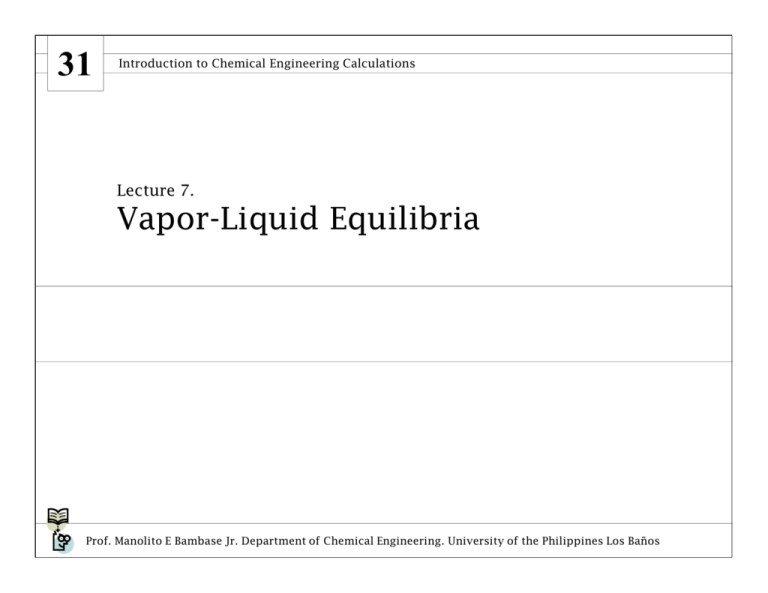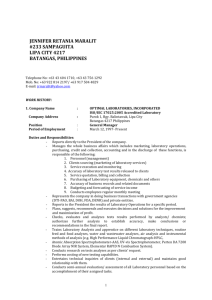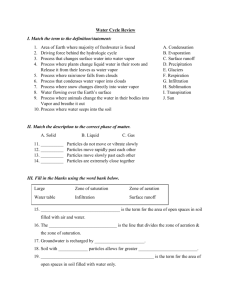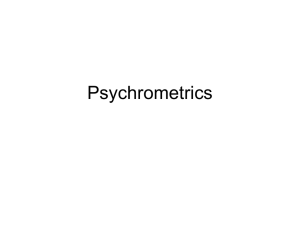Vapor-Liquid Equilibria - Che 31. Introduction to Chemical
advertisement

31 Introduction to Chemical Engineering Calculations Lecture 7. Vapor-Liquid Equilibria Prof. Manolito E Bambase Jr. Department of Chemical Engineering. University of the Philippines Los Baños 7 Vapor-Liquid Equilibria and Saturation Vapor and Gas Vapor A substance that is below its critical temperature. Gas A substance that is above its critical temperature (but below the critical pressure). For the same pressure, a vapor is more easily condensed while a gas is normally non-condensable. Prof. Manolito E Bambase Jr. Department of Chemical Engineering. University of the Philippines Los Baños SLIDE 2 7 Vapor-Liquid Equilibria and Saturation The PT Diagram Prof. Manolito E Bambase Jr. Department of Chemical Engineering. University of the Philippines Los Baños SLIDE 3 7 Vapor-Liquid Equilibria and Saturation Definition of Terms Vapor Pressure Pressure of the vapor when the vapor and liquid of a pure component are in equilibrium. Also referred to as saturated pressure. Saturated Temperature Temperature at which the vapor and liquid will co-exist at a given pressure. Commonly referred to as the boiling or condensation point. Dew Point The temperature when the vapor starts to condense. Bubble Point The temperature when the liquid starts to vaporize. Prof. Manolito E Bambase Jr. Department of Chemical Engineering. University of the Philippines Los Baños SLIDE 4 7 Vapor-Liquid Equilibria and Saturation Definition of Terms Saturated Vapor and Saturated Liquid Vapor and liquid at the saturated P and saturated T. Subcooled Liquid A liquid that is below its saturated T at a given pressure. Compressed Liquid A liquid that is above its saturated P at a given temperature. Superheated Vapor A vapor that is above its saturated T at a given pressure. Quality For a saturated mixture, quality refers to the mass fraction of the vapor in the mixture. Prof. Manolito E Bambase Jr. Department of Chemical Engineering. University of the Philippines Los Baños SLIDE 5 7 Vapor-Liquid Equilibria and Saturation The PT Diagram Prof. Manolito E Bambase Jr. Department of Chemical Engineering. University of the Philippines Los Baños SLIDE 6 7 Vapor-Liquid Equilibria and Saturation The PT Diagram Prof. Manolito E Bambase Jr. Department of Chemical Engineering. University of the Philippines Los Baños SLIDE 7 7 Vapor-Liquid Equilibria and Saturation Saturated and Superheated Steam Tables Prof. Manolito E Bambase Jr. Department of Chemical Engineering. University of the Philippines Los Baños SLIDE 8 7 Vapor-Liquid Equilibria and Saturation Properties of Saturated Mixture For a saturated mixture, ˆ l (1 x) V ˆ g (x) V ˆ mixture V ˆ l (1 x) H ˆ g (x) H ˆ mixture H ˆ l (1 x) U ˆ g (x) U ˆ mixture U where x = mass fraction of vapor in the mixture. Prof. Manolito E Bambase Jr. Department of Chemical Engineering. University of the Philippines Los Baños SLIDE 9 7 Vapor-Liquid Equilibria and Saturation Example 7/8-1. Vapor-Liquid Properties of Water For each of the conditions of temperature and pressure listed below for water, state whether the water is a solid, liquid, saturated mixture, or superheated vapor. If it is a saturated mixture, calculate the quality. State P (kPa) T (K) V (m3/kg) 1 2000 475 --- 2 1000 500 0.2206 3 101.3 400 --- 4 245.6 400 0.505 Prof. Manolito E Bambase Jr. Department of Chemical Engineering. University of the Philippines Los Baños SLIDE 10 7 Vapor-Liquid Equilibria and Saturation Example 7-1. Vapor-Liquid Properties of Water Using the saturated steam table, State P (kPa) T (K) Phase 1 2000 475 Liquid 2 1000 500 Vapor 3 101.3 400 Vapor 4 245.6 400 Saturated Prof. Manolito E Bambase Jr. Department of Chemical Engineering. University of the Philippines Los Baños SLIDE 11 7 Vapor-Liquid Equilibria and Saturation Example 7-1. Vapor-Liquid Properties of Water From the saturated steam pressure table, By 2-point linear interpolation, properties at P = 245.6 can be estimated: ˆ l __________ m3 / kg and V ˆ g __________ m3 / kg V Prof. Manolito E Bambase Jr. Department of Chemical Engineering. University of the Philippines Los Baños SLIDE 12 7 Vapor-Liquid Equilibria and Saturation Example 7-1. Vapor-Liquid Properties of Water If x is the quality of the saturated mixture, then m3 m3 m3 _________ kg 1 x _________ kg x 0.505 kg Solving for x, x = 0.69 Prof. Manolito E Bambase Jr. Department of Chemical Engineering. University of the Philippines Los Baños SLIDE 13 7 Vapor-Liquid Equilibria and Saturation Change of Vapor Pressure with Temperature Many functional forms have been proposed to predict vapor pressure (p*) from temperature. One of these functions is the Antoine equation: B ln (p*) A CT Where p* = vapor pressure of the substance, mmHg T = temperature, K A, B, C = constants for each substance Prof. Manolito E Bambase Jr. Department of Chemical Engineering. University of the Philippines Los Baños SLIDE 14 7 Vapor-Liquid Equilibria and Saturation Change of Vapor Pressure with Temperature The Clapeyron equation is another function relating vapor pressure p* and temperature T: Ĥ V dP * ˆg V ˆl) dT T(V Where p* T HV V g, V l = = = = vapor pressure of the substance temperature latent heat of vaporization specific molar volumes of vapor and liquid, respectively Prof. Manolito E Bambase Jr. Department of Chemical Engineering. University of the Philippines Los Baños SLIDE 15 7 Vapor-Liquid Equilibria and Saturation Change of Vapor Pressure with Temperature Simplifications of the Clapeyron equation: 1. Specific molar volume of liquid is very small compared to specific molar volume of the vapor, such that ˆg V ˆl) V ˆg (V 2. The vapor is assumed to behave ideally. RT V̂g P* Prof. Manolito E Bambase Jr. Department of Chemical Engineering. University of the Philippines Los Baños SLIDE 16 7 Vapor-Liquid Equilibria and Saturation Change of Vapor Pressure with Temperature The Clapeyron equation then becomes, ˆV dP * P * H dT RT 2 Separating the variables and integrating to yield the Clausius-Clapeyron equation, dP * Ĥ V dT P* R T2 Ĥ V ln(P*) B RT Prof. Manolito E Bambase Jr. Department of Chemical Engineering. University of the Philippines Los Baños SLIDE 17 7 Vapor-Liquid Equilibria and Saturation Example 7-2. Estimation of Normal BP Using the Antoine Equation Determine the % error if the Antoine equation is used to estimate the normal boiling point of benzene. From literature value, the normal boiling point of benzene is 353.26 K. Solution: For benzene, values of the constants for the Antoine equation are: A = 15.9008 B = 2788.51 C = -52.36 Prof. Manolito E Bambase Jr. Department of Chemical Engineering. University of the Philippines Los Baños SLIDE 18 7 Vapor-Liquid Equilibria and Saturation Example 7-2. Estimation of Normal BP Using the Antoine Equation Using the Antoine equation, ln (760 mmHg) 15.9008 Solving for temperature, 2788.51 52.36 T T = 353.3 K The percent error is, 353.26 K 353.3K % error 100 0.01% 353.26 K Prof. Manolito E Bambase Jr. Department of Chemical Engineering. University of the Philippines Los Baños SLIDE 19 7 Vapor-Liquid Equilibria and Saturation Example 7-3. Clausius-Clapeyron Equation The vapor pressure of benzene is measured at two temperatures, with the following results: T1 = 7.6 0C T2 = 15.4 0C P*1 = 40 mm Hg P*2 = 60 mm Hg Calculate the latent heat of vaporization and the parameter B in the Clausius-Clapeyron equation and then estimate P* at 42.20C using this equation. Prof. Manolito E Bambase Jr. Department of Chemical Engineering. University of the Philippines Los Baños SLIDE 20 7 Vapor-Liquid Equilibria and Saturation Example 7-3. Clausius-Clapeyron Equation The Clausius-Clapeyron is a linear equation with: 1 x T y ln(P*) Ĥ V m R bB Solving for slope, m: Ĥ V y ln(P *2 ) ln(P *1 ) T1T2 ln(P *2 /P *1 ) m R x T1 T2 1 1 T T 2 1 Prof. Manolito E Bambase Jr. Department of Chemical Engineering. University of the Philippines Los Baños SLIDE 21 7 Vapor-Liquid Equilibria and Saturation Example 7-3. Clausius-Clapeyron Equation Using absolute values for temperature: T1 = 280.8 K and T2 = 288.6 K The slope is computed as: 60 mmHg 280.8 K 288.6 K ln ˆ 40 mmHg H V m R 280.8 K 288.6 K Ĥ V m 4213K R Prof. Manolito E Bambase Jr. Department of Chemical Engineering. University of the Philippines Los Baños SLIDE 22 7 Vapor-Liquid Equilibria and Saturation Example 7-3. Clausius-Clapeyron Equation And the latent heat of vaporization is: J J Ĥ V 4213K R 4213K 8.314 35, 030 mol K mol The intercept b (b = B) can be determined as follows: ˆV ˆV H H B ln(P *1 ) ln(P *2 ) RT1 RT2 4213 B ln(40 ) 18.69 280.8 Prof. Manolito E Bambase Jr. Department of Chemical Engineering. University of the Philippines Los Baños SLIDE 23 7 Vapor-Liquid Equilibria and Saturation Example 7-3. Clausius-Clapeyron Equation The Clausius-Clapeyron equation for benzene can now be written as: 4213 ln(P*) 18.69 T At T = 42.20C = 315.4 K, the vapor pressure of benzene is 4213 ln(P*) 18.69 5.334 315.4 P* exp 5.334 207 mmHg Prof. Manolito E Bambase Jr. Department of Chemical Engineering. University of the Philippines Los Baños SLIDE 24 7 Vapor-Liquid Equilibria and Saturation Vapor-Liquid Equilibrium for Multi-component Systems Consider a binary mixture with components A and B. Vapor YA (PA) YB (PB) Heating Liquid XA0 XB0 Liquid XA XB Note: X, Y = mole fractions of the component in the vapor and liquid phases, respectively. Prof. Manolito E Bambase Jr. Department of Chemical Engineering. University of the Philippines Los Baños SLIDE 25 7 Vapor-Liquid Equilibria and Saturation Vapor-Liquid Equilibrium for Multi-component Systems For multi-component systems, Pi = f(xi) This functional relationship is given by 1. Raoult’s Law – generally used when xi is close to 1. 2. Henry’s Law – generally used when xi is close to 0. Prof. Manolito E Bambase Jr. Department of Chemical Engineering. University of the Philippines Los Baños SLIDE 26 7 Vapor-Liquid Equilibria and Saturation Vapor-Liquid Equilibrium for Multi-component Systems Henry’s Law: Pi = xiHi where Pi xi = partial pressure of component i in the vapor phase. = yiPT (if the vapor behaves ideally) = mole fraction of component i in the liquid phase. Hi = Henry’s law constant Prof. Manolito E Bambase Jr. Department of Chemical Engineering. University of the Philippines Los Baños SLIDE 27 7 Vapor-Liquid Equilibria and Saturation Vapor-Liquid Equilibrium for Multi-component Systems Raoult’s Law: Pi = xiP*i where Pi xi = partial pressure of component i in the vapor phase. = yiPT (if the vapor behaves ideally) = mole fraction of component i in the liquid phase. PT = total pressure Prof. Manolito E Bambase Jr. Department of Chemical Engineering. University of the Philippines Los Baños SLIDE 28 7 Vapor-Liquid Equilibria and Saturation Vapor-Liquid Equilibrium for Multi-component Systems If the vapor behaves ideally, the Raoult’s law becomes yiPT = xiP*i Rearranging the equation, y i P *i Ki xi PT where Ki is the V-L equilibrium constant. Prof. Manolito E Bambase Jr. Department of Chemical Engineering. University of the Philippines Los Baños SLIDE 29 7 Vapor-Liquid Equilibria and Saturation Example 7-4. Vapor-Liquid Equilibrium Calculation Suppose that a liquid mixture of 4.0% n-hexane (A) in n-octane (B) is vaporized. What is the composition of the first vapor formed if the total pressure is 1.00 atm? Values of the Antoine constants for n-octane are: A = 15.9798 B = 3127.60 C = – 63.63 Prof. Manolito E Bambase Jr. Department of Chemical Engineering. University of the Philippines Los Baños SLIDE 30 7 Vapor-Liquid Equilibria and Saturation Example 7-4. Vapor-Liquid Equilibrium Calculation Solution: Assuming the vapor behaves ideally, the composition of the vapor is determined using the Raoult’s law: P *A yA xA PT P *B yB xB PT Prof. Manolito E Bambase Jr. Department of Chemical Engineering. University of the Philippines Los Baños SLIDE 31 7 Vapor-Liquid Equilibria and Saturation Example 7-4. Vapor-Liquid Equilibrium Calculation Upon formation of the first vapor, the composition of the liquid is essentially the same as the initial composition. Hence, xA = 0.040 and xB = 1 – xA =0.960 The vapor pressures of A and B are calculated using the Antoine equation: ln (P*) A B CT Prof. Manolito E Bambase Jr. Department of Chemical Engineering. University of the Philippines Los Baños SLIDE 32 7 Vapor-Liquid Equilibria and Saturation Example 7-4. Vapor-Liquid Equilibrium Calculation For n-hexane: P *A 2697.55 exp 15.8366 48.78 T For n-octane: 3127.60 P *B exp 15.9798 63.63 T Since vaporization temperature is not given, the next step in the calculation is to determine its value. Prof. Manolito E Bambase Jr. Department of Chemical Engineering. University of the Philippines Los Baños SLIDE 33 7 Vapor-Liquid Equilibria and Saturation Example 7-4. Vapor-Liquid Equilibrium Calculation For the vapor mixture, PT = PA + PB Using Raoult’s Law, PT = P*AxA + P*BxB = 1.00 atm = 760 mmHg Using the expressions for the vapor pressures as defined by the Antoine equation e 15.8366 2697.55 48.78 T 0.040 e 15.9798 3127.60 63.63 T 0.960 760 Prof. Manolito E Bambase Jr. Department of Chemical Engineering. University of the Philippines Los Baños SLIDE 34 7 Vapor-Liquid Equilibria and Saturation Example 7-4. Vapor-Liquid Equilibrium Calculation The last equation is a non-linear equation. To find the value of T, Newton’s method is used by defining f(T) as: f(T) = 0.040e 2697.55 15.8366 48.78 T 3127.60 15.9798 63.63 T 0.960e 760 0 Similar to example 6-4, the temperature value that will satisfy this equation is determined using the following iteration formula: f (Tk ) Tk 1 Tk f '(Tk ) Prof. Manolito E Bambase Jr. Department of Chemical Engineering. University of the Philippines Los Baños SLIDE 35 7 Vapor-Liquid Equilibria and Saturation Example 7-4. Vapor-Liquid Equilibrium Calculation Differentiating f(T): f '(T) = 107.902e 15.8366 2697.55 48.78 T T 48.78 2 3002.496e 15.9798 3127.60 63.63 T T 63.63 2 Any value for the temperature may be used as initial guess. For this example, the following initial guess is used: T0 = 1000 K Prof. Manolito E Bambase Jr. Department of Chemical Engineering. University of the Philippines Los Baños SLIDE 36 7 Vapor-Liquid Equilibria and Saturation Example 7-4. Vapor-Liquid Equilibrium Calculation Step TK(K) f(T) f'(T) TK+1(K) E 0 1000.0 313163.50 1109.32 717.70 282.301 1 717.70 74657.88 544.43 580.57 137.13 2 580.57 20838.65 248.65 496.76 83.81 3 496.76 6084.77 111.72 442.30 54.46 4 442.30 1721.87 52.72 409.64 32.66 5 409.64 403.40 29.46 395.95 13.69 6 395.95 51.14 22.21 393.65 2.30 7 393.65 1.24 21.12 393.59 0.06 Prof. Manolito E Bambase Jr. Department of Chemical Engineering. University of the Philippines Los Baños SLIDE 37 7 Vapor-Liquid Equilibria and Saturation Example 7-4. Vapor-Liquid Equilibrium Calculation For T = 393.59 K, the vapor pressures of n-hexane and n-octane are: P*A = 3019.92 mm Hg P*B = 665.86 mm Hg And the composition of the first vapor formed is: 3019.92 0.040 0.159 760 665.68 yB 0.960 0.841 760 yA Prof. Manolito E Bambase Jr. Department of Chemical Engineering. University of the Philippines Los Baños SLIDE 38 7 Vapor-Liquid Equilibria and Saturation Vapor-Liquid Equilibrium for Multi-component Systems Consider a mixture of a vapor (A) and a non-condensable gas (B). Gas Mixture YA (PA) YB (PB) Vapor YA (PA) YB (PB) Cooling Liquid XA Prof. Manolito E Bambase Jr. Department of Chemical Engineering. University of the Philippines Los Baños SLIDE 39 7 Vapor-Liquid Equilibria and Saturation Vapor-Liquid Equilibrium for Multi-component Systems (Terms and symbols in parenthesis refer specifically to air-water system.) Relative Saturation (Relative Humidity) sr h r PV 100 P *V Absolute Saturation (Absolute Humidity) sa h a PVMWV mass of vapor massof vapor-free gas PT PV MWG Molal Saturation (Molal Humidity) sm h m PV moles of vapor molesof vapor-free gas PT PV Prof. Manolito E Bambase Jr. Department of Chemical Engineering. University of the Philippines Los Baños SLIDE 40 7 Vapor-Liquid Equilibria and Saturation Example 7-5. Humidity of Air Humid air at 750C, 1.1 bar, and 30% relative humidity is fed into a process unit at a rate of 1000 m3/h. Determine: a. the molar flow rates of water, dry air, and oxygen entering the process unit. b. the molal humidity and absolute humidity. c. the dew point. Assume ideal gas behavior. Prof. Manolito E Bambase Jr. Department of Chemical Engineering. University of the Philippines Los Baños SLIDE 41 7 Vapor-Liquid Equilibria and Saturation Example 7-5. Humidity of Air Solution for (a): Determine the mole fraction of water: y H 2O PH 2O PT The partial pressure of water is calculated from relative humidity: PH2O hr P *H2O 100 Prof. Manolito E Bambase Jr. Department of Chemical Engineering. University of the Philippines Los Baños SLIDE 42 7 Vapor-Liquid Equilibria and Saturation Example 7-5. Humidity of Air At T = 750C, P*H2O = 289 mm Hg And the partial pressure of water is, PH2O = (289 mm Hg)(0.3) = 86.7 mm Hg For a total pressure of 1.1 bar = 825 mm Hg, the mole fraction of water is, y H2O 86.7 mm Hg mol H 2 O 0.105 825 mm Hg mol HA Prof. Manolito E Bambase Jr. Department of Chemical Engineering. University of the Philippines Los Baños SLIDE 43 7 Vapor-Liquid Equilibria and Saturation Example 7-5. Humidity of Air Determine the molar flow rate of humid air: 1.1bar 1000 m3 / h PV kmol nA 38.0 3 RT h m bar 0.0831 kmol K 75 273K The molar flow rate of water can now be obtained: n H2O kmol HA 0.105 kmol H 2O kmol H 2 O 38.0 3.99 h kmol HA h Prof. Manolito E Bambase Jr. Department of Chemical Engineering. University of the Philippines Los Baños SLIDE 44 7 Vapor-Liquid Equilibria and Saturation Example 7-5. Humidity of Air The molar flow rate of dry air: n DA kmol 1 0.105 kmol DA kmol DA 38.0 34.0 h kmol HA h The molar flow rate of O2: n O2 kmol DA 0.21kmol O 2 kmol O 2 34.0 7.14 h h kmol DA Prof. Manolito E Bambase Jr. Department of Chemical Engineering. University of the Philippines Los Baños SLIDE 45 7 Vapor-Liquid Equilibria and Saturation Example 7-5. Humidity of Air Solution for (b): The absolute humidity (ha): 86.7 18 PH2O MWH2O kg H 2 O ha 0.0726 kg DA PT PH2O MWDA 825 86.7 29 The molal humidity (hm): PH2O mol H 2 O 86.7 hm 0.117 mol DA PT PH2O 825 86.7 Prof. Manolito E Bambase Jr. Department of Chemical Engineering. University of the Philippines Los Baños SLIDE 46 7 Vapor-Liquid Equilibria and Saturation Example 7-5. Humidity of Air Solution for (c): At the dew point, PH2O = P*H2O = 86.7 mmHg From vapor pressure data for water, this vapor pressure of water occurs at: T = 48.70C This is the dew point since at this temperature, water will start to condense. Prof. Manolito E Bambase Jr. Department of Chemical Engineering. University of the Philippines Los Baños SLIDE 47






